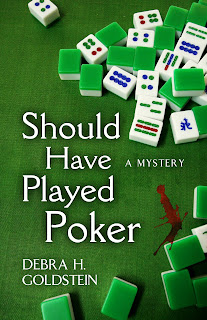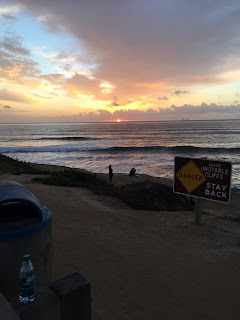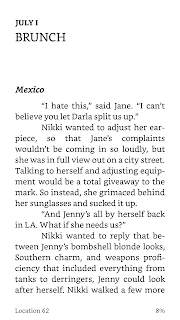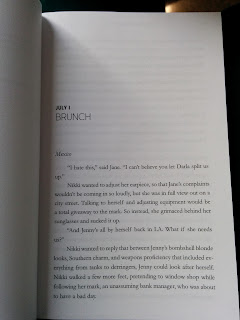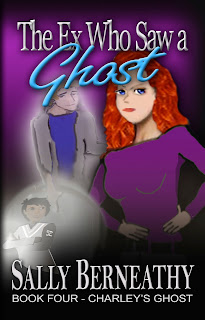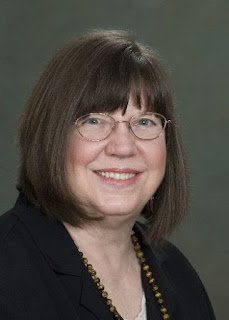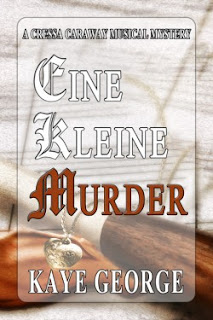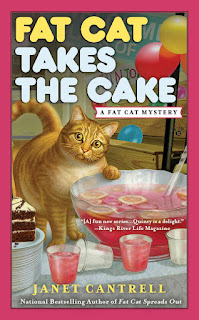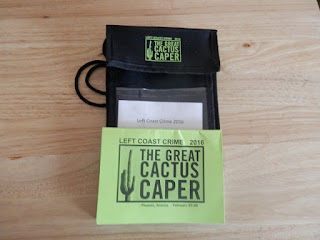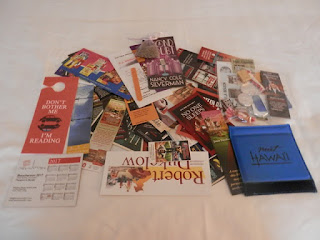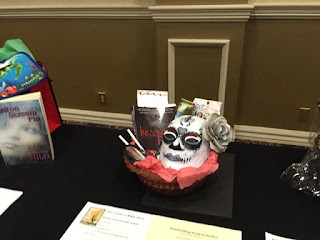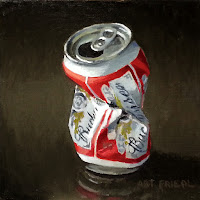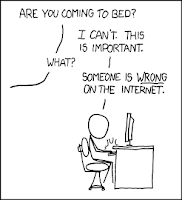This is
my third interview with an author of multiple mystery series. My guest
is Kaye George who is also known as Janet Cantrell. As Kaye, she writes about Imogene Duckworthy, Cressa Carraway, and the (Neanderthal) People of the Wind. As Janet, she pens the Fat Cat cozies. Distinguished for her short stories as well as her mystery novels, Kay has been nominated for an Agatha in two categories (Best First Novel and Best Historical Novel) and served as the President of the Guppy Chapter of Sisters in Crime. Welcome, Kaye/Janet!
How did you initially
decide to write fiction?
It wasn’t a decision. It’s something I’ve
been doing my whole life. I made up stories to go with my crayon drawings
before I could write words. In grade school I drew little comic strips and
sixth grade wrote two “novels”. I think they were about five pages each. In
high school and college, I sent short stories to magazines. I wrote short
stories for creative writing classes in college. I’ve never not written
fiction.
You have published
short stories. How did those help and continue to influence your career?
The first things I got published were
short stories. This was after I gave up on sending them to Atlantic and The New Yorker,
as I’d done for years. I decided to concentrate on novels, thinking I had a
better chance of getting them published. I initially wrote literary fiction,
but soon decided I should write what I most enjoyed reading, and that was mystery.
During the ten years it took to get a mystery novel published, online short
story markets started opening up and I started submitting. I’m still doing
that, along with the novels.
Who publishes each of
your series and how did you begin writing each series?
I’m self-publishing the Imogene Duckworthy
humorous Texas mysteries. The first in that series was the first mystery novel
I got published, but I parted with my publisher after a year. That book won an
Agatha nomination, which my publisher refused to acknowledge. That didn’t sit
well with me! After I republished the first one, CHOKE, I self-published SMOKE
and BROKE pretty quickly. STROKE is in the works.
The first mystery novel I completed and
queried (for about 10 years) is now called EINE KLEINE MURDER, published by
Barking Rain Press. In frustration over my many, many rejections, I turned to
writing the over-the-top Duckworthy series and got that published first. But I
kept coming back to my first love (not my first completed mystery novel, but
the first that I thought had a chance). The main character, Cressa Carraway, is
the successful professional musician I never was. I’ve always been an amateur,
except for some string quartet work that paid pretty well. I’m glad I persisted
and got it out there. It was a Silver Falchion finalist. The second in that
series, REQUIEM IN RED, will come out with the same publisher in April.
I got interested in reading very old
historical fiction, Roman, Greek, ancient Egyptian, and decided I wanted to
take fiction as far back as I possibly could. This was when the Neanderthal DNA
was being analyzed and more and more interest and discoveries centered upon
them. The more I learned, the more I wanted to write about them. DEATH IN THE
TIME OF ICE was the most difficult project I’ve ever done. I ended up using a
somewhat alternative historical setting, putting Neanderthals in North America.
That’s because I also got hooked by the mega-fauna (really, really big
animals!) that roamed this continent at the same time the Neanderthals were a
distinctive people. I got rave rejections for this from some good agents, who
told me they loved my book (!), but didn’t know how to sell it. One night I was
complaining on Facebook that I had gotten yet another of those rejections and
Jay Hartman, from Untreed Reads, who had published some of my short fiction,
asked to see it. And published it! That book was nominated for Best Historical
Agatha Award. The second in that series, which I’m calling People of the Wind,
is DEATH ON THE TREK and will be out in June.
Meanwhile, because I didn’t have enough
to do, I guess, I was hankering after a cozy series. I kept submitting
proposals to BookEnds Literary, an agency that places many cozy mysteries, and
kept getting them rejected. A proposal, I had learned from some experienced cozy
writers, is a detailed synopsis of the first book, the first three chapters,
and sketches for two more in the series. With each of those rejections, it was
like the characters I had created and lived with for at least a month, died. I
got wind of a series I thought I could do, based in Texas where I lived, and
wanted to audition for it, but couldn’t write yet another proposal and get it
rejected. A friend suggested I send in CHOKE instead and inquire about the
series. I did, Kim Lionetti liked my voice, and suddenly, I was agented! I didn’t
get that proposal, but she got me the Fat Cat series. The first two are out,
FAT CAT AT LARGE and FAT CAT SPREADS OUT. The third, FAT CAT TAKES THE CAKE,
will come out in April. I write that series under the name Janet Cantrell.
Did you notice that I have TWO books
coming out in April? Yikes!
How many books do you
write in a year and what is your publication schedule?
I’d like to write one a year, but have
been doing more. The Fat Cat publisher, Berkley Prime Crime, wanted a book
every nine months, so everything else went on hold while I did those three
books. As a result, the second Neanderthal book is coming out a couple of years
after the first one. The second Cressa Carraway was nearly finished a few years
ago, so it wasn’t too hard to get it in shape.
Do you write under
more than one name? If so, was that by your choice or a publisher’s request?
I write mostly as Kaye George. The Fat
Cat series is written as Janet Cantrell because the publisher owns all the rights
to that series. The initial concept was theirs and they own the series, the
characters, and the author name.
What “relationship”
do you have as author with each of your series’ protagonists?
I love all of them! They are all my
children, my creation, born out of labor and love.
Setting has an
important role in each series you write. What is your approach to developing a
setting that fuels the story and draws in readers?
I use west Texas, where I was living
when I started writing the Duckworthy series because I found much to be darkly
humorous about. It’s a harsh place with wonderful people.
I set the Cressa Carraway books in the
Midwest, where I’m from. It seems natural to set them there.
It was requested I set Fat Cat in
Minneapolis, where I’ve also lived. So that wasn’t difficult.
It was very difficult to draw the
setting for the Neanderthals. They lived before the last Ice Age, when there
was no Mississippi River. I had to do tons of research just to describe the
setting. It was all fun, though.
Is it a challenge to
keep coming up with original and inventive plots? How do you do it?
No, the challenge is to find time to
write everything that’s in my head. I had lots more ideas than I’ll ever live
long enough to write.
Since at The
Stilletto Gang we like to delve into shoes and accessories, what are your
protagonists’ favorite foot or carrying apparel? (Pictures are welcome!)
This is the hardest question! I love
shoe shopping, but my feet are hard to fit and I don’t often find shoes I can
buy. I guess that, as a consequence, my characters don’t have too much interest
in shoes.
Immy Duckworthy wears sneakers and
cowgirl boots. Cressa Carraway probably mostly wears sneakers. Well, Chase
Oliver, the Fat Cat’s owner, does, too. (The Fat Cat is named Quincy.) I guess
I’m in a shoe rut! Enga Dancing Flower wraps her feet in skins and ties them
with leather thongs when it’s cold, but she’s barefoot a lot of the time.
Kaye George/Janet Cantrell
Kaye George, national-bestselling and
multiple-award-winning author, writes several mystery series: Imogene
Duckworthy, Cressa Carraway (Barking Rain Press), People of the Wind (Untreed
Reads), and, as Janet Cantrell, Fat Cat (Berkley Prime Crime cozies). The third,
Fat Cat Takes the Cake, will appear April 2016. The second Cressa Carraway
novel, Requiem in Red, will appear in early 2016. The second People of the
Wind, Death on the Trek, comes out in June 2016. Her short stories appear in
anthologies, magazines, and her own collection, A Patchwork of Stories. She
reviews for Suspense Magazine. She lives in Knoxville, TN. http://kayegeorge.com/










